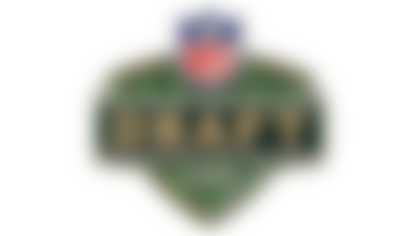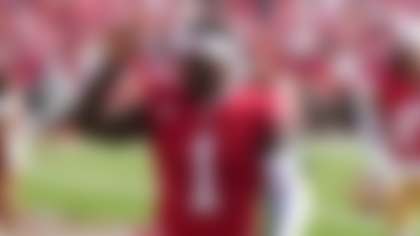Of all the storylines surrounding the 2018 NFL Draft, from the quarterbacks to Saquon Barkley, one group of offensive prospects has been the subject of more skepticism than intrigue: wide receiver. With many bemoaning the lack of Julio Jones- or A.J. Green-level prospects, it is not seen as a premier position in this class. But setting aside that impossible standard, the incoming crop of receivers is chock-full of quality depth, with plenty of players clamoring for top-five receiver status.
One such player is D.J. Moore out of the University of Maryland, who turned heads with an excellent performance at the NFL Scouting Combine. Moore checked in bigger than he was listed in school, at 6-foot and 210 pounds, then proceeded to make noise in the testing portion. Moore blazed a 4.42-second 40-yard dash and leapt 39.5 inches in the vertical and 11 feet in the broad jump, top-five marks at the position in all three drills. The public took notice, with NFL.com draft analyst Mike Mayock bumping Moore up three spots in his most recent positional rankings.
I spoke with Moore in the weeks following the combine, and he confirmed there was a little more attention on him. When I asked what stood out to him from the draft process, he pointed to "people sending links and stuff of me moving up the charts to the top among the wide receivers."
Of course, while it was great to see Moore show some objectively freaky athleticism at the combine, the evidence that he is a high-end prospect is all over his collegiate film, with his game being quite reminiscent of current Detroit Lions wide receiver Golden Tate.
"I would say that's a good comparison," Moore said, agreeing when I ran it by him. "Watching him, he's physical, he does things after the catch that I do similar." Moore also offered up Jarvis Landry as another player who approached the wide receiver assignment with a physical nature.
As we discussed those two players, I mentioned that most NFL passing games today run through the middle of the field and, like Landry and Tate, you must be a badass to play receiver that way.
"Oh, yes, absolutely," Moore replied, with a laugh that confirmed he intends to adopt that same combative nature to his game.
Tate has racked up 90-plus catches in each of his four seasons with the Lions as their primary slot receiver, but he's no stranger to chipping in outside. Tate saw 68 percent of his targets when lined up in the slot in 2017, per Next Gen Stats tracking, but just 31 percent the year prior. Moore sees himself as a player who can execute similar assignments. "Oh, I could play all across the field, play outside or inside. It's in my arsenal to play both and be wherever the team needs me," he proclaimed when asked if he believed his primary home would be inside.
If Moore wants to become a starting-caliber outside receiver in addition to his work from the slot, he'll need to hone his route-running acumen. Luckily, he's already shown he has the potential to be that type of player, having consistently earned separation in college. The key to being a top route-runner is preparation and "just being able to run a route the same way, over and over and over again," Moore told me. He also relayed that his favorite route was the curl, which -- no surprise -- I charted as the pattern he ran most often and consistently gained separation on in college.
As to why he enjoyed running the curl, Moore said, "you can work man or zones. Work behind the zones, sit down in it, come back to the quarterback if it's man." He agreed it was his best route, which is good news for his NFL projection. The curl route is one of the most commonly run routes in the NFL -- if not the most commonly run route -- a major source of chunk passing production in the intermediate area of the field.
As with all prospects, there is room for improvement in Moore's game. He believes the key is continuing to develop as a route-runner, "coming in and out of my routes quicker than what I usually do, because I just know at the next level, they're going to be right there." Honing that quickness against press coverage to consistently earn a clean release at the line of scrimmage will go a long way in Moore's quest to become a No. 1 receiver in the NFL.
After studying his profile and getting a chance to pick his brain about the position, it's impossible not to be optimistic about Moore's chances at NFL success. It should surprise no one if he's the first receiver off the board in April. Moore told me he's had interviews with teams like Dallas, Arizona, Green Bay and others in need of a breath of fresh air in the wide receiver room.
Let's examine several other incoming rookie wide receivers and the pro players to whom they compare favorably:
NFL comp: Martavis Bryant. If you really dig into St. Brown's film and overall profile, it's hard to see why he's not a consensus top-five receiver in this class. Forget the lack of final-year production -- he has it all. St. Brown separates at all levels of the field, whether by his pure athletic ability or an understated ability as a route-runner. To top it all off, he can go up and win the ball in the air and make plays with the ball in his hands. In a class full of complementary No. 2 types, St. Brown's theoretical ceiling stands out. He'll remind observers of the good ol' days of Martavis Bryant with the way he gets open deep and glides through open space after the catch.
NFL comp: Demaryius Thomas. Before he was one of the most productive receivers in the league, stacking multiple 1,000-yard seasons in a row, Demaryius Thomas was an ultra-gifted prospect who needed heavy seasoning. Even when he got rolling with Peyton Manning in Denver, Thomas was never a detailed technician; rather, he made a living on just a handful of routes and his physical gifts. A similar career path could lie ahead for Sutton. A shockingly quick athlete for a player with his frame, Sutton shows flashes of a playing style like Thomas'. If his pro team also gives him the needed time to develop his technical understanding of the game while still reaping the immediate benefits of his raw gifts on big plays, he could bring the same type of upside.
NFL comp: Michael Crabtree.Michael Gallup gives off pro vibes all over his film. From the way he sets up defenders in routes to the consistency with which he makes difficult contested catches look routine, he already looks like an NFL receiver. Gallup plays strong at the catch but runs smooth through his routes to gain separation, especially on intermediate patterns. Everything is in place here for him to be, at worst, a high-end No. 2 receiver in a timing-based offense. The last player to give off these Michael Crabtree-like signals was current Saints wide receiver Michael Thomas. If Gallup also ends up with a quarterback and offense tailor-made for that skill set, he might follow a similar path.
NFL comp: Randall Cobb. One of the more high-profile receivers in this class after a successful career at Texas A&M, Kirk is also one of the many with a wealth of experience in the slot. Clearly an intelligent player who takes his preparation seriously, Kirk is one of the best in this class at sifting through zone traffic. That ability to pop up as an easy target in the holes of zones will ingratiate him to his pro quarterback. Don't underrate his physicality, however. Despite checking in under 6-foot, Kirk is nails at the catch point on contested throws and stronger than most of the defensive backs he competed against in college. At his best, Randall Cobb was a similar player. Back in 2014, Cobb was not only a reliable zone coverage-beater for Aaron Rodgers, but also a trusted physical targeted in the red zone.
NFL comp: Marvin Jones. One of the most productive receivers in college football, the 2017 Biletnikoff Award winner comes to the NFL after racking up over 4,400 yards and 39 touchdowns through four years at Oklahoma State. Washington has all the skills necessary to produce at the next level, especially in some crucial phases. What Washington brings to the table is both rare and valuable: He wins down the field and on contested catches. His college game film is littered with occasions where he adjusts to a deep throw and positions himself to win the ball in the air. No receiver in this draft class can match his ball-tracking ability in the vertical game. While Washington may never check all the boxes of a traditional No. 1 receiver, he can be the lead dog outside for an NFL team based on those two traits alone. We've seen Marvin Jones prove to be that kind of player for the Detroit Lions over the last two seasons.
NFL comp: Greg Jennings. Ridley was the most difficult prospect for whom to assign a clear-cut comparison. He comes with a thin build and didn't show well in the jump drills at the combine, leading to some questions about his athletic ability. However, he consistently gained separation on his routes. Not only does he get open on underneath patterns, but he can shake loose on vertical plays -- he'll be a polished route-runner on Day 1. He showed some struggles with press coverage at the line and snaring contested catches, so his best NFL position may be as a flanker who moves inside to the slot on optimal looks. On the surface, he shares some similarities with current Eagles slot receiver Nelson Agholor, but his outside-route acumen lands him a Greg Jennings comparison. Jennings was both a reliable and big-play target for a pair of elite Packers quarterbacks, and Ridley should earn a passer's trust in a similar fashion.
NFL comp: Steve Johnson. Penn State puts out a strong wide receiver prospect with impressive technique on a near-annual basis. It's no shock that former receivers coach Josh Gattis ended up at Alabama after sending Nittany Lions prospects like Allen Robinson and Chris Godwin to the NFL. Perhaps the most underrated prospect at the position this year, Hamilton is set to join their ranks. He was Penn State's primary slot receiver and is an excellent route-runner. Cover him man-to-man? He'll shake free. Use a zone defense? He'll sift through it. Try and press him at the line? Good luck, if he has a clean release. Some worry about his hands, but there's more than enough evidence on film that he can win tough contested catches. Hamilton's nuanced approach to the game and all-around skill set are similar to what we saw from Johnson. A one-time seventh-round pick, Johnson posted three straight 1,000-yards seasons with the Buffalo Bills from 2010 to 2012 and was a productive role player for the Chargers in 2015 before injuries ended his run. Don't be surprised if Hamilton carves out a similar career.
NFL comp: Doug Baldwin. NFL Network's Steve Smith implied thatAnthony Miller's approach to the game reminded the long-time star receiver of himself, calling Miller one of his "favorite prospects coming into the combine." It's against my personal code to compare a prospect to the ultra-rare No. 89, but it's hard not to trust the source here. I charted his game film, and Miller does give off the vibe of another slight but hyper-competitive wideout in Baldwin. Miller split time between playing the slot and working outside for Memphis. Much like Baldwin, Miller is far more proficient than your typical slot receiver at running deep routes and winning 50-50 balls. He carries the profile of a strong complementary option in an NFL passing game who could stuff the stat sheet with the right quarterback.
Follow Matt Harmon on Twitter _@MattHarmonBYB_.












